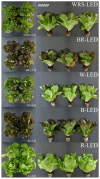Effect of Various LED Light Qualities, Including Wide Red Spectrum-LED, on the Growth and Quality of Mini Red Romaine Lettuce (cv. Breen)
- PMID: 37653973
- PMCID: PMC10223557
- DOI: 10.3390/plants12102056
Effect of Various LED Light Qualities, Including Wide Red Spectrum-LED, on the Growth and Quality of Mini Red Romaine Lettuce (cv. Breen)
Abstract
Recently, LEDs with various light qualities have been used in closed plant factories, and they are known to have different effects on the growth and quality of crops. Therefore, this study was conducted to investigate the change in growth and quality in mini red romaine lettuce using LEDs with various light qualities. Wide red spectrum (WRS)-LEDs, blue (B)-LEDs, blue + red (BR)-LEDs, red (R)-LEDs, and white (W)-LEDs were used as the artificial light sources. Regarding growth, the R-LED treatment showed the most positive effect, but the leaf shape was not normal and the Hunter b* value was not suitable because it was higher than that of the other treatments. The Hunter a*, SPAD, and NDVI values of the B- and BR-LED treatments were effective, but this was not the case for those of the R- and W-LED treatments. The anthocyanin reflectance index 1 (ARI1) was 20 times higher in the B-LED treatment than in the R-LED treatment, and the ascorbic acid content was the highest in the WRS-LED treatment. In the sensory evaluation, bitterness and sweetness showed opposite tendencies. Regarding the overall preference, the BR-LED treatment received the highest score. Correlation analysis showed that the bitterness was closely correlated with the anthocyanin content and leaf color. Taken together, BR-LEDs provided a good top fresh weight, dark red leaves, and high anthocyanin and ascorbic acid contents, with the highest overall preference; therefore, BR-LEDs were the most suitable for the cultivation of mini red romaine lettuce.
Keywords: anthocyanin; bitterness; led; light quality; mini red romaine lettuce.
Conflict of interest statement
The authors declare no conflict of interest.
Figures






Similar articles
-
Side Lighting of Red, Blue and Green Spectral Combinations Altered the Growth, Yield and Quality of Lettuce (Lactuca sativa L. cv. "Yidali") in Plant Factory.Plants (Basel). 2023 Dec 13;12(24):4147. doi: 10.3390/plants12244147. Plants (Basel). 2023. PMID: 38140474 Free PMC article.
-
A strategic approach for investigating light recipes for 'Outredgeous' red romaine lettuce using white and monochromatic LEDs.Life Sci Space Res (Amst). 2018 Nov;19:53-62. doi: 10.1016/j.lssr.2018.09.003. Epub 2018 Sep 18. Life Sci Space Res (Amst). 2018. PMID: 30482283
-
Blue Photons from Broad-Spectrum LEDs Control Growth, Morphology, and Coloration of Indoor Hydroponic Red-Leaf Lettuce.Plants (Basel). 2023 Mar 2;12(5):1127. doi: 10.3390/plants12051127. Plants (Basel). 2023. PMID: 36903988 Free PMC article.
-
Supplementary White, UV-A, and Far-Red Radiation Differentially Regulates Growth and Nutritional Qualities of Greenhouse Lettuce.Plants (Basel). 2023 Sep 12;12(18):3234. doi: 10.3390/plants12183234. Plants (Basel). 2023. PMID: 37765398 Free PMC article.
-
Leaf development and energy yield of hydroponic sweetpotato seedlings using single-node cutting as influenced by light intensity and LED spectrum.J Plant Physiol. 2020 Nov;254:153274. doi: 10.1016/j.jplph.2020.153274. Epub 2020 Sep 6. J Plant Physiol. 2020. PMID: 32961477
Cited by
-
Effects of LED Applications on Dahlia (Dahlia sp.) Seedling Quality.Plants (Basel). 2025 Jul 27;14(15):2319. doi: 10.3390/plants14152319. Plants (Basel). 2025. PMID: 40805668 Free PMC article.
-
Side Lighting of Red, Blue and Green Spectral Combinations Altered the Growth, Yield and Quality of Lettuce (Lactuca sativa L. cv. "Yidali") in Plant Factory.Plants (Basel). 2023 Dec 13;12(24):4147. doi: 10.3390/plants12244147. Plants (Basel). 2023. PMID: 38140474 Free PMC article.
-
Management of Secondary Metabolite Synthesis and Biomass in Basil (Ocimum basilicum L.) Microgreens Using Different Continuous-Spectrum LED Lights.Plants (Basel). 2024 May 17;13(10):1394. doi: 10.3390/plants13101394. Plants (Basel). 2024. PMID: 38794463 Free PMC article.
-
Effects of different light intensity on the growth of tomato seedlings in a plant factory.PLoS One. 2023 Nov 29;18(11):e0294876. doi: 10.1371/journal.pone.0294876. eCollection 2023. PLoS One. 2023. PMID: 38019848 Free PMC article.
-
Light manipulation as a route to enhancement of antioxidant properties in red amaranth and red lettuce.Front Nutr. 2024 Jun 5;11:1386988. doi: 10.3389/fnut.2024.1386988. eCollection 2024. Front Nutr. 2024. PMID: 38899321 Free PMC article.
References
-
- FAOSTAT. [(accessed on 17 November 2021)]. Available online: https://www.fao.org/faostat/en/#data.
-
- Kim M.J., Moon Y., Kopsell D.A., Park S., Tou J.C., Waterland N.L. Nutritional value of crisphead ‘Iceberg’ and romaine lettuces (Lactuca sativa L.) J. Agric. Sci. 2016;8:6. doi: 10.5539/jas.v8n11p1. - DOI
-
- Islam M.Z., Lee Y.T., Mele M.A., Choi I.L., Kang H.M. The effect of phosphorus and root zone temperature on anthocyanin of red romaine lettuce. Agronomy. 2019;9:47. doi: 10.3390/agronomy9020047. - DOI
-
- Seo M.W., Yang D.S., Kays S.J., Lee G.P., Park K.W. Sesquiterpene lactones and bitterness in Korean leaf lettuce cultivars. HortScience. 2009;44:246–249. doi: 10.21273/HORTSCI.44.2.246. - DOI
-
- Park K.W., Lee J.M. Wrap-ups: A unique method of vegetable usage and consumption in Korea. Chronica Hortic. 2006;46:13–15.
Grants and funding
- 122056-3/Korea Institute of Planning and Evaluation for Technology in Food, Agriculture and Forestry (IPET) through the Technology Commercialization Support Program, funded by the Ministry of Agriculture, Food and Rural Affairs (MAFRA)
- NRF-2021R1A6A1A03044242/the Republic of Korea and the Basic Science Research Program through the National Research Foundation of Korea (NRF) funded by the Ministry of Education
LinkOut - more resources
Full Text Sources

